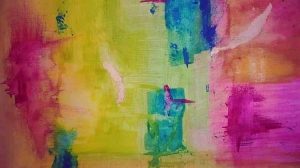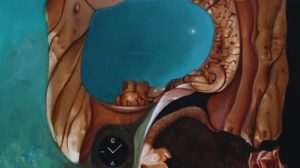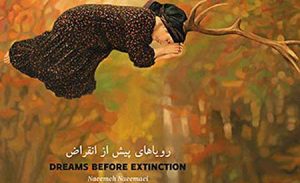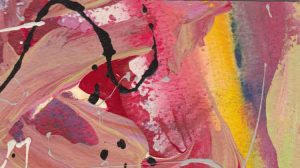Listen and you’ll hear the music in Michelle’s paintings. Of course, they wear the responsibility quite lightly. Incisive and mild, caught and emancipated, real and dreamy, they reach within your grasp like an early morning dream. Listen.
You may not have heard of Michelle Dunaway – yet. A professional artist from New Mexico, Michelle Dunaway has been featured in magazines such as American Artist Workshop, Southwest Art, International Artist, and in the book Strokes of Genius2: The Best of Drawing Light and Shadow.
 Recently, one of her ingenuous art works, “Mucha and Peonies” won the best of the show award in the Raymar Art painting competition, with the judge commenting that “This is a still life with both poetry and music, a very difficult task to pull off, and done so well and creatively in this painting.”
Recently, one of her ingenuous art works, “Mucha and Peonies” won the best of the show award in the Raymar Art painting competition, with the judge commenting that “This is a still life with both poetry and music, a very difficult task to pull off, and done so well and creatively in this painting.”
She started drawing at the age of two, and the first memory, incidentally, is seeing a book of drawing which looked extremely large to the two-year-old eyes (though, in fact, it was of regular size). The first ever oil painting was done as a nine year old, followed by a string of paintings mostly in watercolours in the later years, only to return to oil paintings as a teenager.
The people in Michelle’s painting are caught up by colors and chiselled by bold strokes. Yet, the prevailing emotions remains intact, the paintings alive. When I saw one of her paintings, “Lara’s Legacy,” I became an instant fan. After enjoying more of her creations, especially the chiaroscuro pieces, the questions that arose in my mind, and also the desire to know more about the creator and the creative process, made way for this interview with the young artist.
The Interview
You paint, dabble in photography, and do sculptures as well. How different are these to you?
They are all visual expressions of the same inspiration; they just offer different beauty and joy in the process.
Do you remember the first compliment you received? And, the first critical comment, as well?
I really don’t remember the first compliment or criticism, I would guess the first compliment was probably from my parents when I was little and the first criticism was probably from myself! I’m very much a perfectionist and can be very hard on myself when it comes to my work. I do remember my first sale- In 7th grade, I was drawing in class and a friend offered me her lunch money for the drawing. I remember being shocked that she was going to do without lunch to buy my drawing, it was very touching.
How has growing up in Alaka affected your paintings? Also, there is the definite influence of your parents. Can you tell us more?
Growing up in Alaska was truly magical. There was so much natural beauty to behold and it was like a blank canvas to my imagination as a child. I plan to do a painting trip there in the near future and express visually, in paint, some of my experiences there. My parents have always been amazingly supportive of my artistic path. They brought me up to be independent and encouraged me to nurture my imagination and creativity. I think they realized life isn’t just about “doing” it’s also about listening to, absorbing, and witnessing the world and people around you and then expressing that in some creative way that benefits the world and adds something positive. We all have gifts and I feel we are blessed with these gifts so that we can in turn be a blessing to others through the use of those gifts.
You were at Art Masters Academy with artist Lou Maestas as mentor, and later at Art Center College of Design in California. How much has, you think, this art education helped to shape your works? I ask this as, often, you learn something you enjoy doing, and discover no fun in studying it formally. Did the interest in art ever wane (when in art school)?

You conduct many art workshops around the globe. How different are you as an artist, as a teacher?
I try to be honest in teaching, the same way I try to be honest in painting. As a teacher I’ll cover the necessary basics, but will also talk a lot about the current problem solving and explorations I’m doing in my own work at the moment. As a teacher, I try to impart the knowledge and tools that will help each student improve their work and take them to the next level in their chosen direction. Usually students are at different levels and have different goals they wish to achieve in their painting. I think as a teacher if you can help make someone’s path a little easier and the student leaves the class newly inspired in their work, then you’re doing your job.
I’ve noticed that you appreciate the visual elements surrounding you. And, there’s a profound sense of gratitude for the experience. Looks more like a spiritual experience to me, right?
Yes, my faith is the foundation of all life for me. Art to me is a visual expression of that gratitude. My desire is to create something uplifting, a painting that elevates the viewer to a state of awareness and appreciation. In order to paint that, I must first cultivate that in myself. I begin each day with a prayer of gratitude for the talents entrusted on me and hope that it will bring light in some small way into the life of someone else.
You paint landscapes as well as portraits, but, by comparison, more portraits. Is there any reason for this?
I’ve always been fascinated with people, with facial expressions and hands, with the emotions conveyed through a person’s subtlest movements. Lately I’ve been interested in exploring the aspects of people within the influence of their environments, how they interact with their surroundings and so I’ve started painting people within the landscape more.

Thank you. I was painting at another artist’s home and it is her daughter coming through the doorway. I am often drawn to painting people near windows or doorways because I guess if I think about it, it’s a symbol of transition from the outer to inner world. I like the idea of the light following us when we enter a place, and that the light is always there. Spiritually I believe the light always wrapped around us.
When you see someone, you want to capture them on a canvas. What prompts?
I’ve always felt that since I was three years old, I would want to draw someone and capture a likeness and expression, a moment.
I could be mistaken, but you seem to paint the face and the hands with a controlled carefulness, while the rest of the canvas flows with assured natural strokes. True?
In any portrait, the face will be the focal point, more minutely it will be the eyes. My desire is to paint as closely as I can to the way the human eye sees. Our eyes do not see things as a photograph; they see things with a point of interest focal point surrounded by the abstract elements of color and shape in the peripheral vision. I am interested in exploring how to achieve that effect with paint.
Like fish to water, you like charcoal a lot, don’t you?
I absolutely love charcoal. It’s so fun to work with and you can push it around easily, especially when drawing with powdered charcoal and a brush. I love soft Vine charcoal for figure drawing; it’s very fluid across the paper.
You also have a preference for oil on linen. I am curious to know why.
Linen has a beautiful varied texture that adds a visual interest to me, the brush glides across it differently than canvas which is a uniform texture.
Could you tell us more about your color preferences?
I paint using a double primary palette, 2 of each primary, a warm and cool, with a few earth tones. My palette is Titanium white, cad lemon, cad yellow light, cad red medium, permanent alizarin crimson, yellow ochre, transparent oxide red, cobalt blue light, Ultramarine blue deep, Viridian Green, Permanent Mauve.
Can you describe your studio for us? I take it that you travel a lot; how different is the creative space when travelling?
My studio is near the mountains and is one large room with a large Northeast facing window that looks out to the mountains. On the opposite wall (Southwest) are a row of floor to ceiling windows; there are also two skylights which provide nice even light for working from sunup to sundown. The wall behind my easel is a muted grey green color which is an ideal shade for comparing color against. I love to travel and it’s always inspiring to paint in other creative spaces and visit other artist’s studios.
How long do you paint on a typical day? Apart from the two minute sketches, how long do you take to complete a single work?
It depends on what I’m working on. Really a painting can take as little as several hours to several weeks. It’s not just about the time spent actually painting — most of the time I’ll spend as much if not more time looking, observing, thinking. I never try to make the painting fit into a particular time frame, but let it flow until I feel that it says what I was trying to say through it.
Any particular time for painting? And, any rituals like listening to music, for a start?
I usually paint during the days. My studio has a lot of natural light and I like to make most of painting in natural light. I usually listen to music when I paint — instrumental music.
What is the common observation people make about your paintings? Do the reviews affect you?
The common observation is that I capture the essence of a person, not just their likeness. It makes me happy that people feel that because it’s what I’m feeling when I’m painting and that means it’s getting translated through the paint. Reviews don’t really affect me, I just try to be honest in what I’m doing.
You say, “the essence of the human spirit fascinates me.” Could you elaborate on this?
The essence to me is the core, the spirit, the soul some might say. The part of us that sees out from our eyes, the part of us that is eternal. Despite all of our varied differences as human beings in our experiences, our culture etc., at the essence we are all so similar, we are all brothers and sisters on this journey of life and creativity, we all feel sadness, joy and love.
I love the aesthetic differences we all share like individual snowflakes, with differences in our eye color, hair color, etc. All are equally beautiful and delight my eye as an artist — who paints visually — but my soul, my essence is interested in exploring through my art how we are all connected across time, culture and place, how we are similar in our emotional journeys as human beings.
From a scientific view, in quantum physics, it is said at the core of everything we are pure energy matter, light dancing, all made up from the same substance, all connected to each other.
The artists who have influenced you? And, some of the artists you admire?
I admire John Singer Sargent, Cecelia Beaux, Anders Zorn and Sorolla, I have also been influenced by Morgan Weistling and Jeremy Lipking and Richard Schmid. I also find artistic influence in other mediums; I’m very inspired by the poetry of Mary Oliver, the music of Chopin, the filmmaking of Mira Nair, the writing of Ralph Waldo Emerson. The people that inspire me the most are the ones who share their inspiration of life in their individual medium of choice.
Considering your inspirations (and your creative works) I have to ask. What is your take on abstract/nonfigurative art?

Any sacrifices for the sake of art?
There are always sacrifices made for what you love. Sometimes I’ll spend a lot of time in my studio and miss out on some outings with my friends, but it is all about finding balance. This is what brings me joy, it always has since I was a small girl.
This could be tough question, but what does Art mean to you?
Art means to me, an individual’s personal expression, in some medium, of what inspires their soul, their spirit which then through creation, elevates another’s spirit to appreciation.
At a time when there’s so much uncertainty for art as a career, you are a professional artist. You think art as a career is still viable and very possible?
I think if you truly love what you do and put that love into your work then it will have an impact, no matter what you do. Art will always be necessary to life because inspiration is necessary to live. I see it this way, we could live in a black and white world and still exist, but God gave us color and beauty. Art, whether it’s painting, writing, or some other medium will always be viable and possible because we, as human being, have a need to express our inspirations and share our experiences, it’s what makes life so beautiful.
You can see more of Michelle Dunaway’s art, and learn more about her on her website.




Leave a Reply